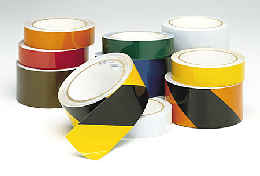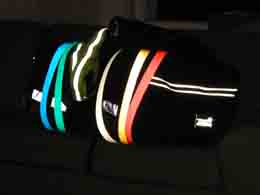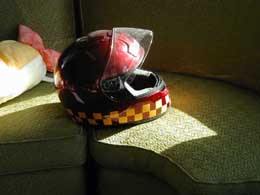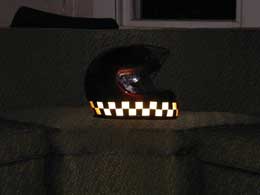Reflective tape.
When my helemet halo gave out and wouldnt' stay on the helmet any longer,
I decided I'd replace it with some sort of sticky reflective tape. I looked around
at the options and discovered theres no way to evaluate reflecty tape
without having it in front of you. There's all these standards, but they're all
self referential or refer to something you can't get to.
The products don't say anything useful except for things like "complies with
ASTM 40-D" or "meets or exceeds specifications set forth in DOT-5563 sec. 2"
but no where can I find what any of those actually
mean * or even how they compare to each other.
So, what I did instead is just get some tape that wasn't too expensive
and had a rating from Lab Safety and
Supply and tried it out.
This
is what I got in blue, green, white/silver, yellow, and red.
The photos don't show that the tape really isn't as good as the bandolier I got
from motormarket, or the 3M Scotchlite that's on the saddlebags, but it does show that
it's still pretty good, especially for $6.20 / 15 feet.

 The one on the left is my crappy picture taken with a flash in a dark room. The reflection is strong enough that they appear more white than they really are, especially the yellow. On the right is the photo from the manufacturer, of what it looks like in normal light. It seems pretty accurate.
The one on the left is my crappy picture taken with a flash in a dark room. The reflection is strong enough that they appear more white than they really are, especially the yellow. On the right is the photo from the manufacturer, of what it looks like in normal light. It seems pretty accurate.
For the helmet I cut the yellow tape into a bunch of 1" lengths,
(1" squares). Starting at the front center I stuck one against the bottom
edge centered on the helmet. Then I used another square of tape or the
backing I'd just pulled off to allign the second one so the top corners
were exactly one inch apart, and the bottom edge was against the bottom
edge of the helmet.
I did this all the way to the back of the helmet (except for the last
few) and then put the second row on. This allowed the intersections to
line up so the corners looked right, but it still followed the contours of
the helmet. It means the blocks aren't all paralell, but it works anyway.
It wouldn't work on a three layer checkerboard I don't think.
For the back I looked at the space left and trimmed the remaining squares
so they fit with as little distortion as I could. I was lucky that it
worked almost perfectly. The front of the helmet has a square centered,
the back has a boundry between squares centered, but you'd never notice
that there was a difference without counting.

 on the left, in a dark room with a flash, on the right,
no flash, in the sun. The reflection from the flash is bright enough
that the yellow looses it's color and appears white.
on the left, in a dark room with a flash, on the right,
no flash, in the sun. The reflection from the flash is bright enough
that the yellow looses it's color and appears white.
I think the checkers are more noticable than the the solid band I had with
the helmet halo. It gives it a British-policeman look I rather like.
I think it looks pretty good, I'm happy with the result.

 The one on the left is my crappy picture taken with a flash in a dark room. The reflection is strong enough that they appear more white than they really are, especially the yellow. On the right is the photo from the manufacturer, of what it looks like in normal light. It seems pretty accurate.
The one on the left is my crappy picture taken with a flash in a dark room. The reflection is strong enough that they appear more white than they really are, especially the yellow. On the right is the photo from the manufacturer, of what it looks like in normal light. It seems pretty accurate.

